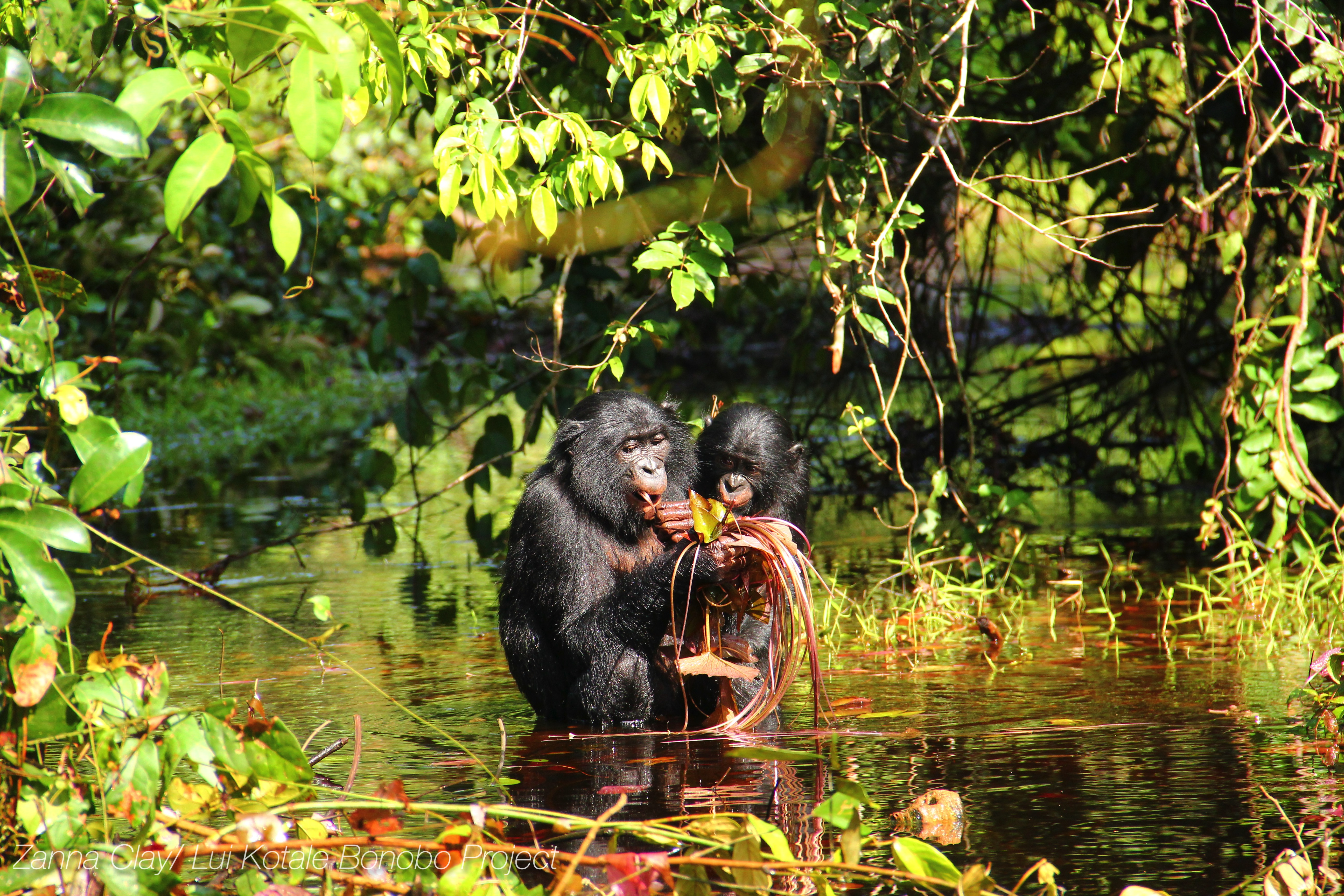Bonobo communication is a fascinating area of study that reveals striking similarities to human language. Like humans, bonobos utilize vocalizations that can form complex messages, suggesting a primitive form of bonobo language. Researchers have discovered that these animals combine sounds in intricate ways to express various social situations, a process that mirrors the concept of compositionality in animals. This linguistic creativity highlights the evolutionary roots of language, indicating that the mechanisms of animal communication are more sophisticated than previously thought. Understanding bonobo vocalizations not only enhances our comprehension of animal communication but also sheds light on the evolution of language itself.
The ways in which bonobos convey messages are deeply complex and comparable to the verbal exchanges we see among humans. This captivating form of animal communication showcases the nuances of sound combinations and meanings crafted by these intelligent primates. Researchers have observed that the intricate vocal patterns of bonobos serve crucial social functions, allowing for the coordination of group behaviors and the expression of emotions. By studying these vocal interactions, we gain valuable insights into the cognitive processes that may underpin language evolution. Thus, exploring the communicative capabilities of bonobos offers an enriching perspective on the broader spectrum of animal linguistics.
Understanding Bonobo Communication
Bonobo communication is a fascinating aspect of animal behavior, reflecting intricate social systems and relationships within their communities. Unlike other primates, bonobos utilize a complex array of vocalizations, which researchers have noted include different types of calls such as peeps, yelps, and whistles. These sounds are employed not merely for alerts or basic interactions but carry layers of meaning that denote specific actions or emotional states. For instance, a bonobo’s subtle peep preceding a whistle indicates a tense situation, emphasizing the animal’s ability to convey nuanced information akin to human language.
This communicative sophistication in bonobos challenges previously held views about the evolution of language in humans. Research has unearthed that various vocal combinations correspond to specific social contexts and actions, much like how humans form sentences by combining words. This compositionality — the ability to craft new meanings by blending simpler elements — plays a crucial role in establishing and maintaining social bonds. By conducting detailed studies and observations, researchers have begun to chart these vocalizations, essentially creating a bonobo dictionary that reflects their complex communication patterns.
The Role of Vocalizations in Social Structure
In bonobos, vocalizations serve as vital tools for navigating their social intricacies. These chimps often split into smaller foraging parties, requiring effective communication to regroup. The complexity of their social interactions necessitates a language-like system that allows for the conveyance of information across distances. This dynamic echoes human experiences where communication aids in the coordination of group activities and fosters community ties. The ability to emit specific calls signals not just alerts but also intentions, emotions, or descriptions of events in their environment.
Research indicates that the evolution of vocal complexity among bonobos parallels that of humans, underscoring the connection between social structure and communication. For example, calls can convey commands like ‘Run!’ or describe emotional states such as ‘I am afraid.’ This interdependence suggests that as bonobos’ social structures mature, their communication systems evolve correspondingly, further cementing the notion that advanced vocal behaviors may offer insight into the early stages of human language development.
Compositionality in Bonobo Vocalizations
Compositionality is a cornerstone of language evolution, reflecting the capacity to create new meanings through combinations of simpler elements. Bonobo vocalizations exemplify this principle, showcasing their ability to combine calls in ways that form intricate messages. Researchers have meticulously documented these call combinations, revealing that bonobos can express a wide range of meanings that reflect their social interactions and environmental contexts. For instance, identifying a predator might not just be a straightforward alarm but instead involves a series of vocal cues signaling urgency and the nature of the threat.
The findings regarding compositionality in bonobo communication draw intriguing comparisons to human language structures. Just as humans may say, ‘the big dog,’ bonobos can link vocalizations to contextual cues that signify larger meanings. This discovery enhances our understanding of animal communication and provides critical insight into how the capacity for language might have evolved from simpler forms to the complexity seen in modern humans. Thus, the study of bonobo vocalizations not only sheds light on their social behaviors but also on the lineage of human language advancement.
Implications for Understanding Animal Communication
The implications of understanding the vocal communication of bonobos extend far beyond their species. By establishing a robust framework for interpreting animal sounds, researchers can glean insights into how complex social systems influence communication across various species. The structured approach used to create a bonobo dictionary is groundbreaking, as it highlights key aspects of vocal behavior that are often overlooked in simpler social setups. By applying methodologies from human linguistics, scientists have begun to explore the subtle nuances that dictate how animals express themselves.
Moreover, the recognition of compositional language in bonobos suggests that this communicative feature may exist across other animal species with similar social complexities. The parallels found in chimpanzees show that combinatorial structures are not unique to humans or bonobos. Analyzing these patterns enriches our understanding of evolutionary biology, exposing potential links between social relationships and communication strategies, essential for maintaining group dynamics in various animals.
The Evolutionary Context of Bonobo Language
Examining the evolutionary context of bonobo communication offers a deeper understanding of the roots of language. As bonobos share a common ancestor with humans, studying their vocal behaviors may provide clues about the evolution of human communication. Researchers suggest that the linguistic capabilities seen in bonobos hint at an ancestry where language was not solely a human trait but a complex system that evolved alongside social organization in primates. This perspective implies that the seeds of language and social interaction were present long before the emergence of modern humans.
The evolutionary significance of bonobo vocalizations underscores the complex relationship between social bonds and communication. As these primates showcase advanced methods of expression through vocalizations, it becomes evident that language may have developed as a tool for navigating intricate social landscapes. The ability to convey intricate emotional states or group intentions through sound suggests that primates adapted their communication in tandem with their evolving societies, establishing foundational elements of what would later develop into human language.
Impacts of Social Structure on Bonobo Communication
The social structure of bonobos significantly influences their communication methods, making the nature of their interpersonal relationships a crucial aspect of how they express themselves. Bonobos live in matriarchal societies where females often hold the power, which has led to the development of unique vocal patterns reflective of these social dynamics. The way bonobos vocalize in various contexts, such as during foraging or social interactions, provides insight into how social hierarchies and roles shape their communication style. Their ability to modulate vocalizations depending on the audience demonstrates a level of social awareness that parallels human social behaviors.
As bonobos demonstrate a wide range of social interactions — from nurturing mothers vocalizing to their infants to adults coordinating movements across larger distances — the evolution of these communication strategies reveals much about their societal needs. Vocalizations enable bonobos to navigate their social environments effectively, indicating that communication serves as a tool not just for expression but also for maintaining social order and relationships. The study of these vocal behaviors reinforces the importance of social structures in shaping the communicative capabilities of different species, suggesting a broader evolutionary narrative.
Bonobo Communication in Comparative Perspectives
When comparing bonobo communication to other primates, notable similarities and differences emerge that shed light on the evolution of language. While chimpanzees have been studied intensively regarding vocalizations, the distinction lies in the degree of social complexity and communication style. Bonobos, with their unique social structures and maternal emphasis, develop more intricate vocal systems. This suggests that as societies evolve, so too does their capacity for complex communication, reinforcing the idea that language is tied closely to social organization.
The comparative analysis of bonobo and chimpanzee vocalizations further underlines the importance of environmental factors in shaping communication practices. For example, while chimpanzees may utilize singular vocal calls effectively, bonobos illustrate how combining calls allows for a richer conveyance of meanings. This points to the necessity of understanding animal communication within its ecological and social contexts, offering vital information on how evolutionary pressures guide the development of sophisticated communication systems across different primate species.
The Future of Bonobo Research
The future of bonobo communication research holds profound implications for our understanding of not only primate behavior but also the origins of human language. As the methodologies for studying animal communication continue to advance, ensuring that non-human vocalizations are systematically analyzed becomes paramount. More extensive research can unveil the depths of bonobos’ communicative capabilities, potentially leading to new insights into the cognitive processes that underlie their vocalizations.
Investing in long-term studies will help illuminate the evolving nature of bonobo communication within changing social structures and ecological conditions. The exploration of vocalizations in varying contexts can provide a more comprehensive understanding of language-like features in non-human species. By comparing bonobos with other primates and integrating findings from various disciplines, researchers can bridge gaps in our knowledge, enhancing our appreciation for the complexities of animal communication and its evolutionary significance.
Applications of Bonobo Vocalization Studies
The applications of studying bonobo vocalizations extend to multiple fields, including conservation biology, linguistics, and cognitive science. Understanding how bonobos communicate can inform conservation efforts, particularly in maintaining social structures critical for their survival in the wild. As we learn more about their vocal patterns and social interactions, this knowledge equips conservationists to create environments that uphold their natural behaviors, thereby boosting the effectiveness of preservation strategies.
Moreover, insights gained from bonobo vocalization studies can inform theories in linguistics about the evolution of human language. By drawing parallels between bonobo communication and human linguistic traits, researchers can glean clues about the cognitive underpinnings of language development. Additionally, these studies may offer valuable lessons about the role of social interaction in shaping language, potentially influencing educational approaches, communication strategies, and our understanding of animal cognition across species.
Frequently Asked Questions
What is bonobo communication and how does it compare to human language?
Bonobo communication refers to the vocalizations and social signals used by bonobos, which exhibit characteristics similar to human language. Researchers have found that bonobos use equivalents of word compounds and phrases, suggesting that their communication involves compositionality—an ability to form new meanings by combining vocalizations, similar to how humans create sentences.
How do bonobo vocalizations demonstrate compositionality in animal communication?
Bonobo vocalizations show compositionality by allowing the combination of different calls to convey complex meanings. For instance, a bonobo’s ‘peep’ followed by a ‘whistle’ can indicate social tensions or specific actions. This structured form of communication parallels human language, where modifiers and phrases are used to articulate nuanced ideas.
What findings did researchers discover about bonobo language evolution?
Researchers at the University of Zurich and Harvard found that bonobos possess characteristics of language evolution, including the ability to create complex vocal combinations. Their study indicates that the roots of language may predate humans, as bonobos demonstrate sophisticated vocal behaviors linked to their social structures, enhancing our understanding of language evolution.
Why is studying bonobo communication important for understanding animal communication?
Studying bonobo communication is crucial because it provides insights into the complexity of vocalizations and the social structures of animals. By creating a ‘dictionary’ of their calls, researchers can better understand how complex communication systems evolve, showing that sophisticated animal communication is not exclusive to humans.
In what ways do bonobo vocalizations influence their social interactions?
Bonobo vocalizations significantly influence their social interactions by coordinating group movements and expressing emotions or commands. For example, specific calls can signal immediate needs or inform others about environmental dangers, thereby maintaining social bonds and effective group dynamics.
How do bonobo social bonds relate to their communication systems?
Bonobo social bonds are intricately linked to their communication systems. Their sophisticated vocal communication helps maintain relationships over distances, facilitating social organization and interactions. As demonstrated in studies, the complexity in their social structures necessitates equally complex means of communication.
What techniques do researchers use to study bonobo vocalization and communication?
Researchers studying bonobo vocalization often utilize observational methods combined with linguistic analysis. By categorizing calls based on context—such as social interactions and environmental factors—scientists can systematically analyze the meanings and functions of bonobo vocalizations within their social groups.
How do bonobos use vocalizations to manage their social complexity?
Bonobos use a variety of vocalizations to manage their social complexity by signaling different actions, expressing emotions, or coordinating movements with group members. Their ability to combine calls into meaningful sequences allows them to navigate intricate social situations, reflecting the deep connection between social relationships and communication.
| Key Points |
|---|
| Mia, a young female bonobo, vocalizes to distant group members. |
| Bonobos use vocalizations similar to human word compounds, indicating complex communication. |
| A study by researchers at the University of Zurich and Harvard suggests roots of language predate humans. |
| Compositionality allows bonobos to create new phrases to convey complex social situations. |
| Bonobos exhibit sophisticated vocal behaviors to coordinate movements over distance. |
| Research involved detailed observations over eight months, creating a ‘dictionary’ of calls. |
| Findings show that both bonobos and chimpanzees have complex communication reflecting their social structure. |
Summary
Bonobo communication reveals fascinating insights into the linguistic abilities of our closest living relatives. This study signifies that bonobos not only vocalize but also use complex combinations of sounds akin to human language, highlighting that the roots of communication may stretch back millions of years before our species even existed. By understanding their sophisticated vocalizations, we gain valuable perspectives on the evolution of social interactions among primates.








